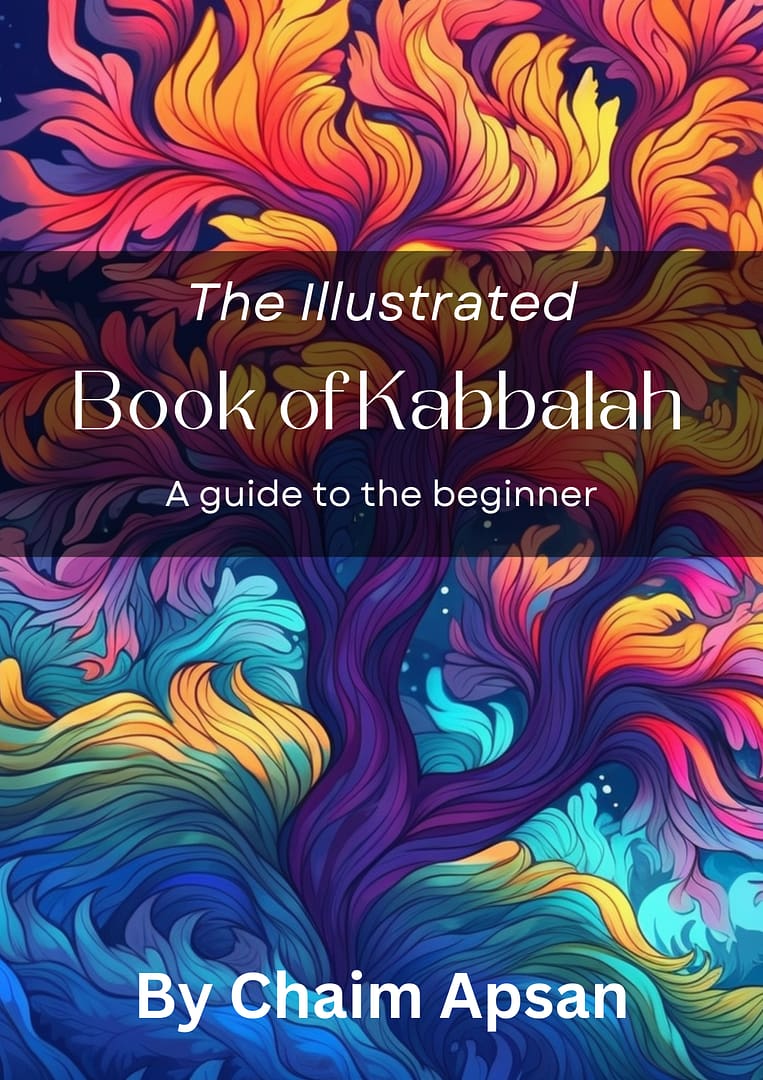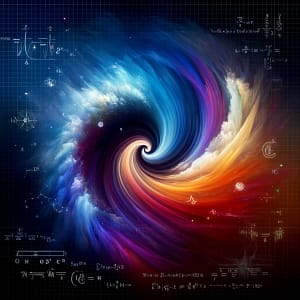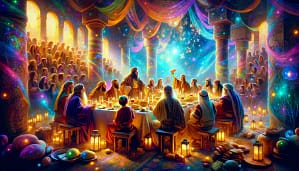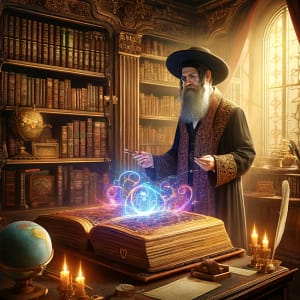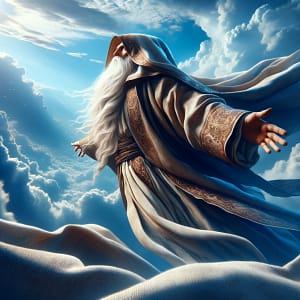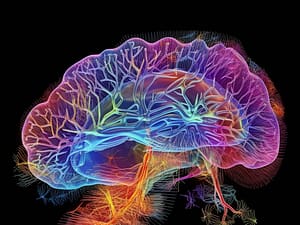The Kabbalistic principle of relativity should not be confused with the relativity principle in physics
Yes, I know the physics principle of relativity has nothing to do with “everything is relative”, but the Kabbalistic principle of Arachim (lit: values, but I think relativity is a better translation) does and not in a simple way.
The Holy Rabbi Shalom Sharabi (the Rashash) revealed to us four Kabbalistic principles that help us understand the Kabbalah of the Arizal (R’ Yitzhak Luria). Without them, we are left wondering how to solve the many contradictions, confusions, and lack of explanations in his writings.
While the Rashash is not so well known except to Sephardim, he’s the primary source and ultimate arbiter in matters of Kabbalah and interpreting the Arizal. At first, the Rashash’s writings seem at odds with the Arizal’s, but once we get into it, we realize there could be no other way to know them. While he seems to “twist” the Arizal’s words, in reality he’s simply “clarifying” and suddenly everything makes sense.
The Rashash is reputed to have been the reincarnation of the Arizal, who guaranteed his disciple Rabbi Chaim Vital he’d come back to clarify his Torah. Indeed, that was what the Rashash did and many Tzadikim like Ben Ish Chai, Rav Chaim Palagi and other Sephardi Kabbalists wrote that he was indeed the reincarnation of the Arizal. In their minds, he revealed so much and in such an ingenious and fascinating way that there could be no other explanation.
Here we will attempt to delve into 2 great Chiddushim of his.

A little disclaimer
The following is my analysis of a quote by Rav Eliezer Berland, whom I very much respect and admire. As many of my readers will know by now, I am (or try to be) a Chasid of Rav Eliezer Berland. Rav Berland helped us greatly, and I have no doubts that ALL accusations against him are FALSE.
If you haven’t yet read my arguments in his favor, and against the whole gang of snakes that went against him, go here.
On another note, this post is only my take and I don’t claim to “know everything” or be “Hashem’s secretary” (as I was once accused of pretending to be) especially considering everything Hashem does has multiple facets and lessons we can learn from.
I could be wrong and I am happy to be corrected if someone has a better explanation.
But this just makes a lot of sense to me and so I’m posting.
Also, I understand people are distressed and indeed, it’s been heavy days since the tragedy that our people suffered on Oct. 7. They obviously didn’t suffer for nothing, and did a lot of Tikkunim through that and I don’t mean to diminish their merit at all.
Yet, for the sake of Torah, there’s a very big question that’s been troubling me and a lot of people.
The words of Rav Eliezer Berland

In the wake of the horrific tragedies where more than 1,400 Jews died, Rav Berland said something very powerful. I can’t find the exact words, but it was more or less like this:
“All those that died in the war and in the massacre died Al Kiddush Hashem ascend to the highest levels of heaven. They go to the place where Avraham, Yitzhak and Yaakov in Gan Eden and are greeted by them
While I can appreciate the sentiment and wish this is so, this quote seems to fly in the face of the simplest principle of “reward and punishment“, present virtually everywhere, including Tanach, Talmud, Zohar, Midrashim, Mussar, Kabbalah and Halacha. This is such a basic principle that even non-religious Jews and non-Jews are aware of and understand it clearly.
In a nutshell: You receive in the next world according to your spiritual level. You are responsible for your deeds and you will be judged according to them. Nobody gets a free pass in Hashem’s court and everyone is judged according to what he/she could’ve achieved. This is a very real Kabbalistic principle that needs to be properly expounded upon and there are some exceptions.
How, then, can we understand Rav Berland’s quote about blanket-sending everyone to Gan Eden? And what about us Torah-abiding Jews who didn’t merit this?
The first thing to know as a basic fact is that a real Tzadik, especially one like Rav Berland, often conceals his intentions and his words convey a lot more than their simple meaning. A real Tzadik would also never distort the words of Torah and our sages merely to “be nice” and comforting (which is a real need in these times, of course).
Our sages teach that a Jew who died at the hands of the non-Jews has indeed a great reward. Death (or rather, being murdered) atones for a lot (including the desecration of Hashem’s name), if not everything wrong a person did in his lifetime. Many of his sins are erased. There are numerous sources for this.
Nevertheless, one cannot get the Torah or other positive Mitzvot he was supposed to get in the physical realm anywhere else. Gehinom helps cleanse a person but it does not complete a person’s Torah that he was supposed to have studied. Only reincarnation does, either by Yibur or Gilgul and this we learn from Sha’ar HaGilgulim.
Many religious Jews might be asking: if people who died get everything then what is the point of trying to be a good Jew and follow Torah and Mitzvot? Let’s temporarily disregard the fact that no one knows when he will die in order to hedge on the last moment of Teshuva and get all the rewards.
This question got me perplexed until I (believe I) found the solution from the Torah of the great Rabbi Shalom Sharabi.
And this fits beautifully like a glove.
The Kabbalistic principle of relativity
The Kabbalistic principle of relativity (arachim) teaches that everything (except for Ein Sof) is relative. The order of the Partzufim (spiritual systems) exists only because we perceive them that way, but in all technical sense – writes Rabbi Shalom Sharabi – they are all levels of the same light which manifest differently. We perceive them in different settings as they vest themselves, but the only real change is the degree to their “purity” and “brightness”.
So, for example:
- The Sephira of Gevurah (might) would turn brighter by going up, it could become Binah (understanding) which is a lot smoother, as it does happen in the order of descent of Mokhin to Z”A.
- One person could be a Tzadik in a certain place filled with Reshaim, but be a Rasha in another filled with Tzadikim.
- An idea that is obvious to some people and is rooted in their lower levels of NAHY (Netzach, Hod and Yesod) may sound wondrous to another one for whom this same idea is in their CHABAD (Chokhmah, Binah, Da’at) or even then as a Makkif only (an encircling light).
- The order of today’s prayer services is new because it is built upon yesterday’s service, but will become old and serve as the basis for tomorrow.
This explains how we all have our different Partzufim (spiritual systems) to fix but they are fixed relative to us, and that is what we are Mekaven.
The Kabbalistic principle of depth and length
We all know by now the Tree of Life diagram which is essentially a sort of a “metaphysical map of all Creation”. It is (another) Kabbalistic principle that every facet of life follows this pattern as I explained in my e-book:

Everything we are doing is meant to rectify a Partzuf (or many Partzufim) that follows more or less this array. Our human body is structured in a way that also resembles the Tree of Life diagram and all areas of Torah, especially the Holy Zohar, are filled with allusions to it.
The Kabbalistic Principle of Depth and Length establishes that there are in fact 2 main forms we can consider the Partzuf (spiritual system) we are dealing with: depth or length.
Length means when we consider them containing a top-down relationship and we have the Tree of Life arranged as most people know. First Keter, then Chokhmah, then Binah, and so on until Malkhut. The key distinction here is that the Sephirot are either higher or lower than each other. This is called the “Orech” (length) system or the “Prati” (individual) system, and this was pretty much the way people understood the Kabbalah of the Arizal, until the Rabbi Shalom Sharabi came.
Depth means when we consider the entire array of Sephirot displayed in concentric circles stemming from the Kav HaEin Sof (the Line of Ein Sof) at the center of Creation. This arrangement can be related to the order of generations, as the earlier generations are closer to the center and each have their own systems of “length” for each and every individual within it. But the key distinction here is that the Sephirot between 2 systems of “depth” are more or less in the same height. This arrangement is called “Oivy” (thickness or depth) system or the “Klali” (general) system.
I know this may sound confusing, but this distinction created by Rabbi Shalom Sharabi helps us understand many difficulties in Torah. Think of different systems of elements within them. In essence, we are either comparing the systems themselves or analyzing the elements within them.
Noach: Tzadik or not?
This Kabbalistic principle of relativity and of depth helps us understand many conundrums in Torah and conciliate contrasting opinions. This is the beauty of the wisdom of Kabbalah which is rooted in Chokhmah: It unites everything and helps us harmonize them in our heads.
Using these two principles, we can better analyze the famous question whether Noach was a Tzadik only in his generation or also in Avraham Avinu’s generation. Based on the first verse of Parshat Noach:
אֵ֚לֶּה תּֽוֹלְדֹ֣ת נֹ֔חַ נֹ֗חַ אִ֥ישׁ צַדִּ֛יק תָּמִ֥ים הָיָ֖ה בְּדֹֽרֹתָ֑יו אֶת־הָֽאֱלֹהִ֖ים הִתְהַלֶּךְ־נֹֽחַ
Translation: These are the generations (or offspring) of Noach. Noach was a righteous man, perfect in his generations. With Elohim Noach walked.
The commentators debate whether this verse is to Noach’s merit or detriment.
- Was he a Tzadik only “in his generations” in which case he’d have been mediocre in Avraham Avinu’s?
- Or would he have been an even greater Tzadik had he had Avraham Avinu next to him?
We can apply these two Kabbalistic principles and say Elu v’elu divrei Elohim Chaim (these and these are the words of the living God), i.e.: both.
Noach had great merits but clearly didn’t reach his full potential as he’s credited with the Mabul (flood) being called by his name. Our sages say that he didn’t pray enough and didn’t do enough to convince people in his generation to do Teshuva. In the Zohar (Noach) Hashem actually insults him after Noach questions his motives after everyone died.

Yet, the beginning of the verse showers him with praise saying he was Tamim (“perfect”). Even though Hashem says “I found you righteous in this generation”, it’s very unlikely the Creator would employ ambiguous language to say Noach was lacking.
So, we could say that Noach
The solution that I propose is:
- In the Partzuf HaKlali (general spiritual system of “depth”) of his generation he was evidently the Tzadik Yesod Olam of his generation since he was the only one saved, however…
- In his Partzuf HaPrati (individual spiritual system of “length”) Noach still lacked a lot as we learn from our Jewish sages, especially in the Zohar where Hashem rebukes him.
- Had he been in Avraham Avinu’s generation, Noach would’ve been average in the Partzuf HaKlali (general spiritual system of “depth”), however…
- Being in the presence of Avraham Avinu would have certainly had a strong influence on him to reach the full potential of his Partzuf HaPrati (individual spiritual system of “length”).
But, sure enough, I don’t think anyone could’ve compared to Avraham Avinu who was indeed the Tzadik Yesod Olam.
With this, I believe all opinions are satisfied and we can interpret both sides to both generations.
Concluding remarks
With these two Kabbalistic principles, we can now understand what Rav Berland meant with his quote.
The Jews who died truly reached a tremendously high level and made wondrous Tikkunim. This was the “Orech” (length/individual) system of them. They reach their highest possible level for them in that specific situation. They deserve, on their own level, to bask in the lights of Chesed, Gevurah and Tiferet (also called Avraham, Yitzhak and Yaakov).
Yet, someone who is striving to come closer to Hashem every day with self-sacrifice, studying, purifying himself and never giving up is going up on the generation’s spiritual system of “depth“. He may not merit the “highest levels of Heaven”, but he might be higher in comparison even while being in the lower levels of the “length” system.
Two other things to keep in mind is that each of the 4 spiritual worlds of Atzilut, Beriyah, Yetzirah and Assiyah have “heavens”. This is in fact one of the terms used to describe the Partzuf of Ze’ir Anpin.
Of course, in the end only Hashem knows what is in each and everyone’s heart and who’s higher than whom.
For our part, we can only lament those who died and hope that Hashem avenge their blood and destroy our enemies. May we all merit to do complete Teshuva, reach the highest levels, and see the building of our Third Temple.

